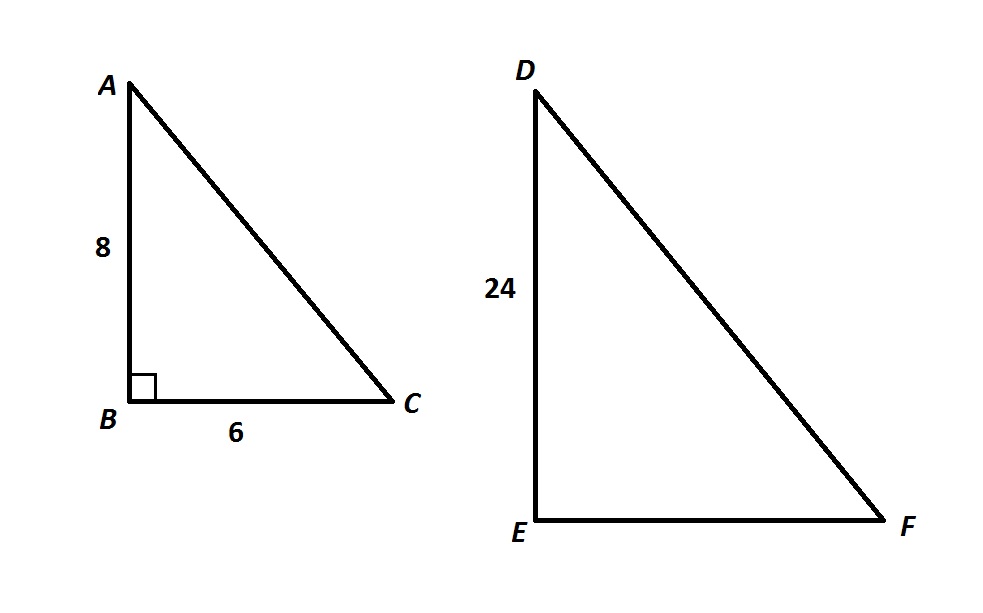All GED Math Resources
Example Questions
Example Question #252 : Geometry And Graphs
Which of the following statements follows from the statement 
The similarity of two triangles implies nothing about the relationship of two angles of the same triangle. Therefore, 
The similarity of two triangles implies that corresponding angles between the triangles are congruent. However, because of the positions of the letters, 






Similarity of two triangles does not imply any congruence between sides of the triangles, so 
Similarity of triangles implies that corresponding sides are in proportion. 






Example Question #1 : Similar Triangles And Proportions

Note: Figure NOT drawn to scale.
Refer to the above diagram. If 

Suppose 
Corresponding angles of similar triangles are congruent, so 



Corresponding sides of similar triangles are in proportion. Since

the similarity ratio of 

By the Pythagorean Theorem, since 



But 

Example Question #4 : Similar Triangles And Proportions

Note: Figures NOT drawn to scale.
Refer to the above figures. Given that 

By the Pythagorean Theorem, since 

The similarity ratio of 


Likewise,
Example Question #5 : Similar Triangles And Proportions

Note: Figures NOT drawn to scale.
Refer to the above figures. Given that 

Corresponding angles of similar triangles are congruent, so, since 



By the Pythagorean Theorem, since 

The similarity ratio of 


This can be used to find 

The area of 

Example Question #2 : Similar Triangles And Proportions
In the figure below, the two triangles are similar. Find the value of 

Since the two triangles are similar, we know that their corresponding sides must be in the same ratio to each other. Thus, we can write the following equation:
Now, solve for 
Example Question #1 : Pythagorean Theorem
The two legs of a right triangle measure 30 and 40. What is its perimeter?
By the Pythagorean Theorem, if 

Substitute 

The perimeter of the triangle is
Example Question #2 : Pythagorean Theorem
A right triangle has legs 30 and 40. Give its perimeter.
The hypotenuse of the right triangle can be calculated using the Pythagorean theorem:
Add the three sides:
Example Question #3 : Pythagorean Theorem
A right triangle has one leg measuring 14 inches; its hypotenuse is 50 inches. Give its perimeter.
The Pythagorean Theorem can be used to derive the length of the second leg:

Add the three sides to get the perimeter.

Example Question #2 : Pythagorean Theorem
Whicih of the following could be the lengths of the sides of a right triangle?
7 inches, 2 feet, 30 inches
15 inches, 3 feet, 40 inches
10 inches, 1 foot, 14 inches
2 feet, 32 inches, 40 inches
2 feet, 32 inches, 40 inches
A triangle is right if and only if it satisfies the Pythagorean relationship
where 

7 inches, 2 feet, 30 inches:
2 feet is equal to 24 inches. The relationship to be tested is

10 inches, 1 foot, 14 inches:
1 foot is equal to 12 inches. The relationship to be tested is

15 inches, 3 feet, 40 inches:
3 feet is equal to 36 inches. The relationship to be tested is

2 feet, 32 inches, 40 inches:
2 feet is equal to 24 inches. The relationship to be tested is

The correct choice is 2 feet, 32 inches, 40 inches.
Example Question #3 : Pythagorean Theorem
An isosceles right triangle has hypotenuse 80 inches. Give its perimeter. (If not exact, round to the nearest tenth of an inch.)
Each leg of an isosceles right triangle has length that is the length of the hypotenuse divided by 

The perimeter is the sum of the three sides:


All GED Math Resources



































































